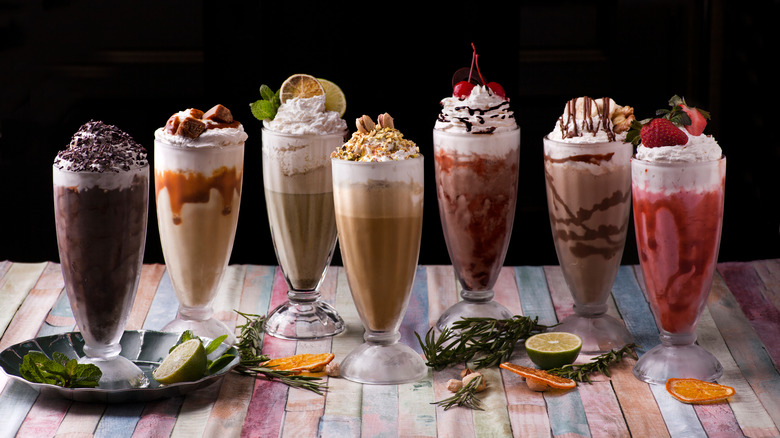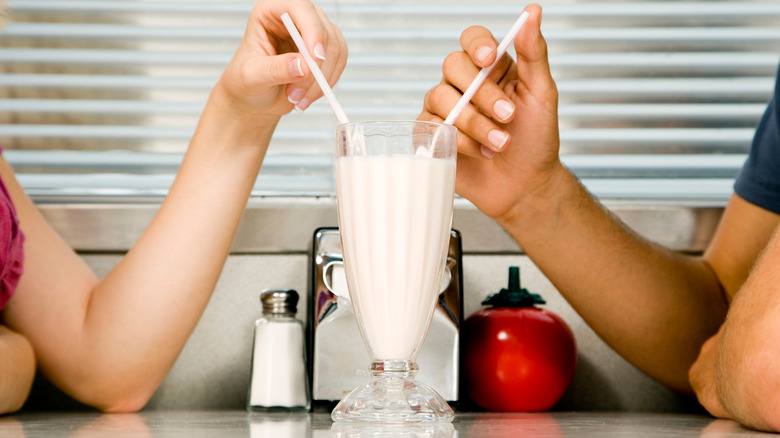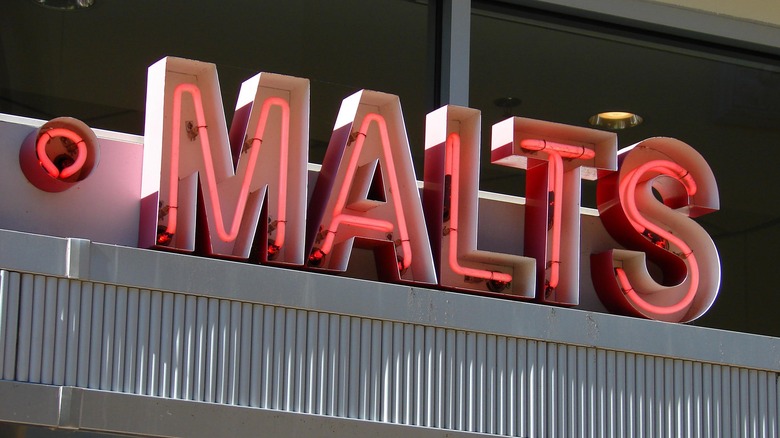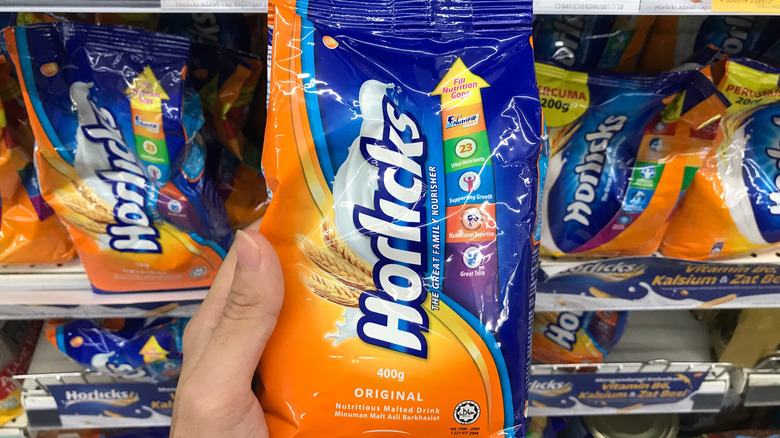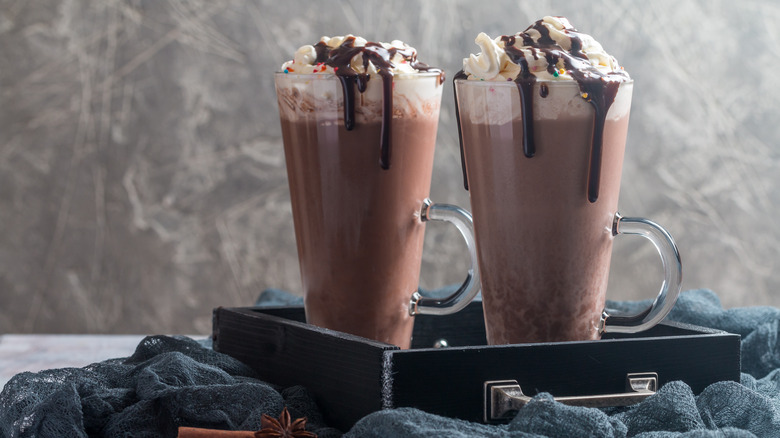The Real Difference Between A Shake And A Malt
Is there a better place to grab a bite to eat than your local diner? Sure, the food and drinks may not exactly be five-star, but these types of eateries typically have a wide range of options to satisfy you whether you're going for breakfast, lunch, or dinner. Pair the extensive menu with leather booths and nostalgic decor and you've almost got a scene straight out of "Riverdale," just don't forget to order a scrumptious milkshake to sip on while you indulge in your meal.
Speaking of milkshakes, what's your favorite flavor? Most places will offer the classic trio of chocolate, vanilla, and strawberry, and maybe even a few more adventurous flavors like birthday cake. Some restaurants might even have a second list of drinkable ice cream treats to choose from that identify as malts — what in the world are those?
If you've never heard of these old-timey desserts, rest assured, they hardly have the taste of the malt vinegar that you douse your fish and chips in. These days, a malt is simply a regular milkshake that has a few scoops of malted milk powder added to it, though that wasn't always what you'd be served if you ordered one. As it turns out, the original version of the malt was actually the basis for the milkshakes we drink today. So, how did we go from one to the other, and how exactly are they different? Here's what you need to know.
What is a milkshake?
Milkshakes are one of the easiest ways to get your ice cream on the go with the added bonus of being relatively mess-free, but what exactly goes into making the sippable treat? Not much — it contains ingredients like ice cream, milk, and any other flavoring agents like chocolate sauce or fruit. Had we been talking about them in 1885, however, the recipe for the dessert would be a little different. In fact, it wouldn't even be a dessert recipe at all, as the beverage actually originated as a cocktail that consisted of whiskey and eggnog (via LONDNR).
Milkshakes became a "wholesome drink" that everyone could enjoy just a few years later (via Cold Stone), but it wasn't until 1922 that today's version of the treat came into fruition thanks to Ivar Coulson, the manager of a Chicago Walgreens who Food History says upgraded his store's malted milk drink by adding vanilla ice cream to it, thus creating the first-ever milkshake. The concoction quickly became a hit at malt shops throughout America and soon landed its first home in the fast food world, when it was introduced to the Dairy Queen menu in 1949, where it happens to still reign supreme as one of the best milkshakes around. These days, milkshakes can be found almost anywhere, though the malted milk powder found in the original version is not added in unless a malt is specifically ordered.
What is a malt?
Malts may not be the leading drinkable dessert these days, but the truth is that without them, there would be no milkshakes for us to enjoy on a hot summer day. The sweet-tasting beverages dominated the drink scene in the early 1900s when "malt" was the short form of "malted milk," which was a treat that consisted of milk, chocolate syrup, and malted milk powder. The ingredients were shaken up with ice to get a frothy texture and slurped down at malt shops, formerly known as soda shops, that were typically found inside drug stores (via Delighted Cooking).
It was at one of these drug stores — the aforementioned Walgreens in Chicago, to be more specific — that Coulson added ice cream into the mix. The malted milk powder was eventually nixed from the dessert's recipe, giving us the modern-day milkshake. However, some restaurants and diners still list malts on their menus. This usually refers to a malted milkshake, which is a milkshake with a few scoops of chocolate or vanilla-flavored malted milk powder added to it, rather than the original ice cream-free malted milk beverage that was served during the beginning of the 20th century.
What is malted milk powder?
To truly understand what a malt is, and what makes it different than a milkshake, you have to know about its key ingredient — malted milk powder. The substance was invented in the 1800s by brothers James and William Horlick, who set out to create an alternative food supplement for babies (via Delighted Cooking). The pair combined together powdered milk, wheat flour, and malted barley. The result was a nutrient-rich powder that is described as having a sweet and nutty flavor. The Horlick Brothers' creation was soon adopted by explorers, who appreciated the product for being lightweight and non-perishable. However, the powder's rich flavor appealed to even more people, leading to the invention of the malted milk drink and, eventually, the milkshake.
Malted milk powder was eventually phased out of the recipe for the drinkable dessert, though some restaurants, like Five Guys, still offer it as a mix-in. The ingredient is also available for purchase at grocery stores in both chocolate and vanilla flavors and can be incorporated into a number of sweet treats like cookies, frosting, and, of course, malted milk balls.
Here's how milkshakes and malts are different
If you were to order both a milkshake and a malt the next time you head out for a meal at your local diner, it would probably be hard to differentiate between the two on looks alone. Both will probably be served in the same tall, ridged glass that's possibly accompanied by an extra metal canister of leftovers on the side, and will have the appearance of being thick and creamy. It won't be until you take a swig of each (or a spoonful, if that's your preferred method) that you'll really be able to figure out what distinguishes one from the other.
The addition of malted milk powder will further enhance the flavors of your sweet treat, giving it a much richer flavor than that of a regular milkshake. You may also notice that it takes a bit more work to sip your malt through a straw, as its signature ingredient makes the consistency of the drink a bit thicker than the alternative.
In terms of nutrition, milkshakes and malts are fairly similar. Both should be enjoyed sparingly, as they are high in both sugars and fat, though the latter has a slight edge since malted milk powder is high in nutrients such as vitamin D and potassium. Choosing between the two ultimately comes down to whichever one you think tastes better, but if you ask us, you really can't go wrong either way.
